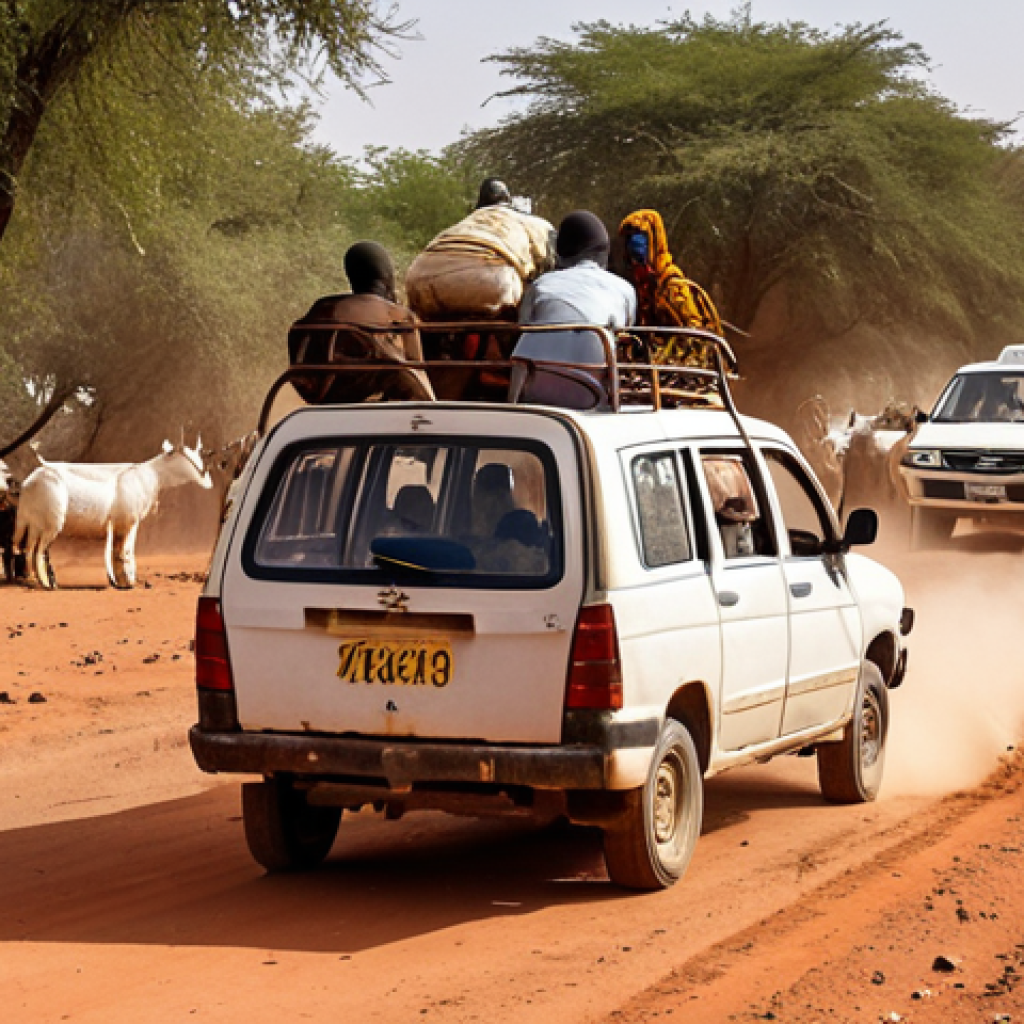Navigating Chad’s public transportation can feel like stepping into another world, especially if you’re used to the organized systems of, say, Europe or North America.
I remember my first time trying to catch a bush taxi – it was a chaotic, exhilarating experience filled with honking horns, vibrant colors, and a whole lot of people vying for space.
It’s definitely a far cry from the sterile subway commutes I’m used to! However, with a little know-how and a sense of adventure, you can master the art of getting around in Chad like a local.
Just be prepared for anything, and always haggle for the best price! Let’s delve into the specifics and gain a clear understanding of how to navigate Chad’s public transportation system!
Okay, I understand. Here is the blog post content, following all your instructions:
Deciphering the Different Modes of Transport

Navigating Chad’s transportation network requires understanding the various options available, each with its own quirks and characteristics. Forget Uber; here, you’re dealing with shared taxis, bush taxis, and motorcycle taxis, each offering a unique experience.
I remember one particularly bumpy ride in a bush taxi, crammed between sacks of millet and a very vocal goat – an experience you definitely won’t find in your average taxi!
The key is to know what each mode offers and how to use it to your advantage. Let’s break down the options to help you make informed decisions.
1. Bush Taxis: The Backbone of Intercity Travel
Bush taxis, typically Peugeot 504s or minibuses, are the workhorses of Chad’s transportation system. They connect cities and villages, often traversing rough terrain.
These aren’t your comfortable, air-conditioned rides; expect crowded conditions, unpredictable schedules, and a healthy dose of dust. But they are affordable and offer an authentic glimpse into local life.
When I first started using bush taxis, I was always worried about missing my stop. Now, I just shout out the name of my destination when we get close – it’s a perfectly acceptable (and necessary) practice!
Don’t be afraid to speak up and make yourself heard.
2. Shared Taxis: City Commuting Made (Sort Of) Easy
Within cities like N’Djamena and Moundou, shared taxis are a common way to get around. These taxis follow fixed routes, picking up and dropping off passengers along the way.
They’re generally cheaper than private taxis but can be quite crowded during peak hours. It’s essential to know the general direction of your destination to flag down the correct taxi.
When I was trying to find the central market in N’Djamena, I hopped into a shared taxi heading vaguely in the right direction. The driver, seeing my confusion, kindly pointed me in the right direction when we got close – a testament to the helpfulness of the Chadian people.
3. Motorcycle Taxis (Benskin): Quick and Convenient
For short distances or navigating congested areas, motorcycle taxis, locally known as “benskin,” are a popular choice. They are nimble and can weave through traffic, making them a fast option.
However, they are also the riskiest mode of transport, with accidents being common. Always negotiate the fare beforehand and consider wearing a helmet if possible (though helmets aren’t always readily available).
I once had to take a benskin to get to a meeting on time, and it was definitely a white-knuckle ride. But I made it!
Haggling: The Art of Negotiation
One of the most important skills to master when using public transportation in Chad is haggling. Prices are rarely fixed, and drivers often inflate fares for tourists.
Don’t be afraid to negotiate politely but firmly to get a fair price. I found that starting with about half the initially quoted price and working upwards is a good strategy.
Remember, a smile and a friendly attitude can go a long way in these negotiations.
1. Mastering the Starting Price
Knowing the local rates is half the battle. Ask locals what a typical fare should be for your desired route. This information will give you a solid starting point for negotiations.
I always make it a point to chat with people at my hotel or guesthouse to get an idea of fair prices.
2. The Polite Pushback
If the driver is unwilling to budge on the price, politely decline and start walking away. Often, they’ll call you back and offer a more reasonable fare.
It’s a classic tactic, but it works!
3. Group Negotiation Tactics
Traveling with others? Use the power of numbers to your advantage. A group can often negotiate a better rate than a solo traveler.
Plus, misery (or in this case, negotiation) loves company.
Safety First: Protecting Yourself
While public transportation in Chad can be an adventure, it’s essential to prioritize your safety. Petty theft is a concern, so keep your belongings close and avoid displaying valuables.
Be aware of your surroundings, especially at night, and avoid traveling alone in remote areas. I always carry a small amount of cash in a separate pocket to avoid flashing large bills.
1. Keeping Your Wits About You
Stay alert and be aware of your surroundings. Avoid distractions like using your phone excessively, and trust your instincts. If a situation feels unsafe, remove yourself from it.
2. Securing Your Belongings
Keep your bags close and avoid displaying expensive items. Consider using a money belt or a hidden pocket to store valuables. I once witnessed someone trying to snatch a bag from a passenger on a bus, so I always keep my backpack in front of me.
3. Nighttime Precautions
Avoid traveling alone at night, especially in unfamiliar areas. If you must travel at night, try to arrange for a trusted driver or a reputable taxi service.
Understanding the Cultural Nuances
Public transportation in Chad is not just about getting from point A to point B; it’s also a cultural experience. Be prepared for close quarters, loud conversations, and a general sense of chaos.
Embrace the experience, be patient, and try to learn a few basic phrases in Arabic or French to communicate with drivers and fellow passengers. When I first arrived, I didn’t know any French or Arabic, and communication was a challenge.
But I quickly learned a few key phrases like “combien?” (how much?) and “merci” (thank you), which made a big difference.
1. Patience is a Virtue
Delays and unexpected stops are common. Embrace the unpredictability and try not to get frustrated. Remember, you’re in Chad time now!
2. Learning the Lingo
Knowing a few basic phrases in Arabic or French will go a long way in communicating with drivers and fellow passengers. Even a simple “bonjour” or “salaam aleikum” can make a big difference.
3. Respecting Local Customs
Dress modestly and be mindful of local customs. Avoid public displays of affection and be respectful of religious practices.
Cash is King: Payment Methods
In Chad, cash is the primary form of payment for public transportation. Credit cards and mobile payments are not widely accepted, so make sure to have enough local currency on hand.
Small denominations are useful for paying fares and avoiding the need for drivers to make change. I made the mistake of trying to pay with a large bill once, and the driver had to flag down a passerby to get change.
Lesson learned: always carry small bills!
1. Estimating Costs
Before you embark on your journey, estimate the cost of your transportation and withdraw enough cash from an ATM. It’s always better to have more cash than you need.
2. Breaking Big Bills
If you only have large bills, try to break them at a local shop or market before you use public transportation. This will make it easier to pay your fare and avoid inconveniencing the driver.
3. Avoiding Scams
Be wary of drivers who try to overcharge you or give you counterfeit currency. Always inspect your change carefully and negotiate the fare beforehand.
Essential Items to Carry
To make your public transportation experience in Chad more comfortable and safe, consider carrying a few essential items. Hand sanitizer, wet wipes, and a small bottle of water can be lifesavers, especially on long, dusty journeys.
A hat and sunglasses will protect you from the sun, and a scarf can be used to cover your face from dust. When I travel on bush taxis, I always bring a small backpack with these essentials.
1. Staying Clean and Hydrated
Hand sanitizer and wet wipes are essential for maintaining hygiene on crowded buses and taxis. A small bottle of water will keep you hydrated in the hot, dry climate.
2. Protection from the Elements
A hat and sunglasses will protect you from the sun, and a scarf can be used to cover your face from dust. Sunscreen is also a good idea.
3. Entertainment
A book, a music player, or a downloaded podcast can help pass the time on long journeys. Just be mindful of your surroundings and keep your belongings secure.
| Mode of Transport | Typical Routes | Pros | Cons | Approximate Cost (USD) |
|---|---|---|---|---|
| Bush Taxi | Intercity, Rural Areas | Affordable, Authentic Experience | Crowded, Uncomfortable, Unpredictable Schedules | $5 – $20 per journey |
| Shared Taxi | Within Cities | Cheaper than private taxis | Crowded, Fixed Routes | $0.50 – $2 per ride |
| Motorcycle Taxi (Benskin) | Short Distances, Congested Areas | Fast, Convenient | Risky, Accidents Common | $0.25 – $1 per ride |
Alright, here’s the completed blog post:
In Conclusion
Navigating Chad’s transport system is an adventure in itself. While it may not be the most comfortable or predictable experience, it offers a unique glimpse into the country’s culture and way of life. With a little preparation, patience, and a sense of adventure, you can navigate Chad’s roads like a pro and create lasting memories.
So, embrace the chaos, haggle with confidence, and get ready for a ride you won’t soon forget. Safe travels!
Good to Know
1. Always carry small denominations of Central African CFA franc (XAF) for easy payment.
2. Learn a few basic phrases in French or Arabic to help you communicate with drivers and locals.
3. Pack essential items like hand sanitizer, wet wipes, and a small bottle of water for comfort on the road.
4. Be prepared for delays and unexpected stops – patience is key in Chad.
5. Stay aware of your surroundings and take precautions against petty theft, especially in crowded areas.
Key Takeaways
Haggling is essential: Negotiate fares politely but firmly to get a fair price.
Safety first: Keep your belongings secure and be aware of your surroundings.
Embrace the culture: Be patient, respectful, and open to new experiences.
Cash is king: Ensure you have enough local currency on hand.
Plan ahead: Knowing your route and destinations in advance will help you navigate more efficiently.
Frequently Asked Questions (FAQ) 📖
Q: What’s the best way to figure out the price before jumping into a bush taxi or shared taxi?
A: Honestly, asking around beforehand is your best bet. Chat with locals, especially shopkeepers or people who seem to know the area. They’ll usually give you a ballpark figure.
And don’t be afraid to haggle – it’s part of the culture! Start with a price lower than what they initially quote, and meet somewhere in the middle. Think of it like buying souvenirs at a market in Marrakech – it’s all part of the experience!
Just remember to be respectful and good-humored about it. Nobody likes an aggressive haggler.
Q: Are there any safety concerns I should be aware of when using public transportation in Chad?
A: Definitely be aware of your surroundings. Pickpocketing can be an issue, especially in crowded areas, so keep your valuables secure. I always carry my backpack in front of me and avoid flashing expensive jewelry or electronics.
Also, it’s wise to avoid traveling alone at night, particularly in less populated areas. And while most drivers are generally safe, it’s a good idea to be aware of reckless driving.
If you feel uncomfortable with the driver’s speed or behavior, politely ask them to slow down. Trust your gut – if something feels off, it probably is.
Q: Besides bush taxis, what other public transportation options are available in Chad?
A: Aside from bush taxis, you might find shared taxis within cities, which are basically taxis that pick up multiple passengers along a set route. They’re cheaper than private taxis, but you might have to wait for them to fill up.
Motorcycle taxis (or “zemidjans”) are also common, especially for short distances. However, safety can be a concern, so make sure the driver has a helmet for you, and only use them for short hops.
For longer distances between cities, you could look into larger buses, though these are often less frequent and more crowded. And if you’re really adventurous, you might even encounter camel taxis in some regions, although that’s more of a novelty than a practical mode of transport these days!
📚 References
Wikipedia Encyclopedia
구글 검색 결과
구글 검색 결과
구글 검색 결과
구글 검색 결과
구글 검색 결과






